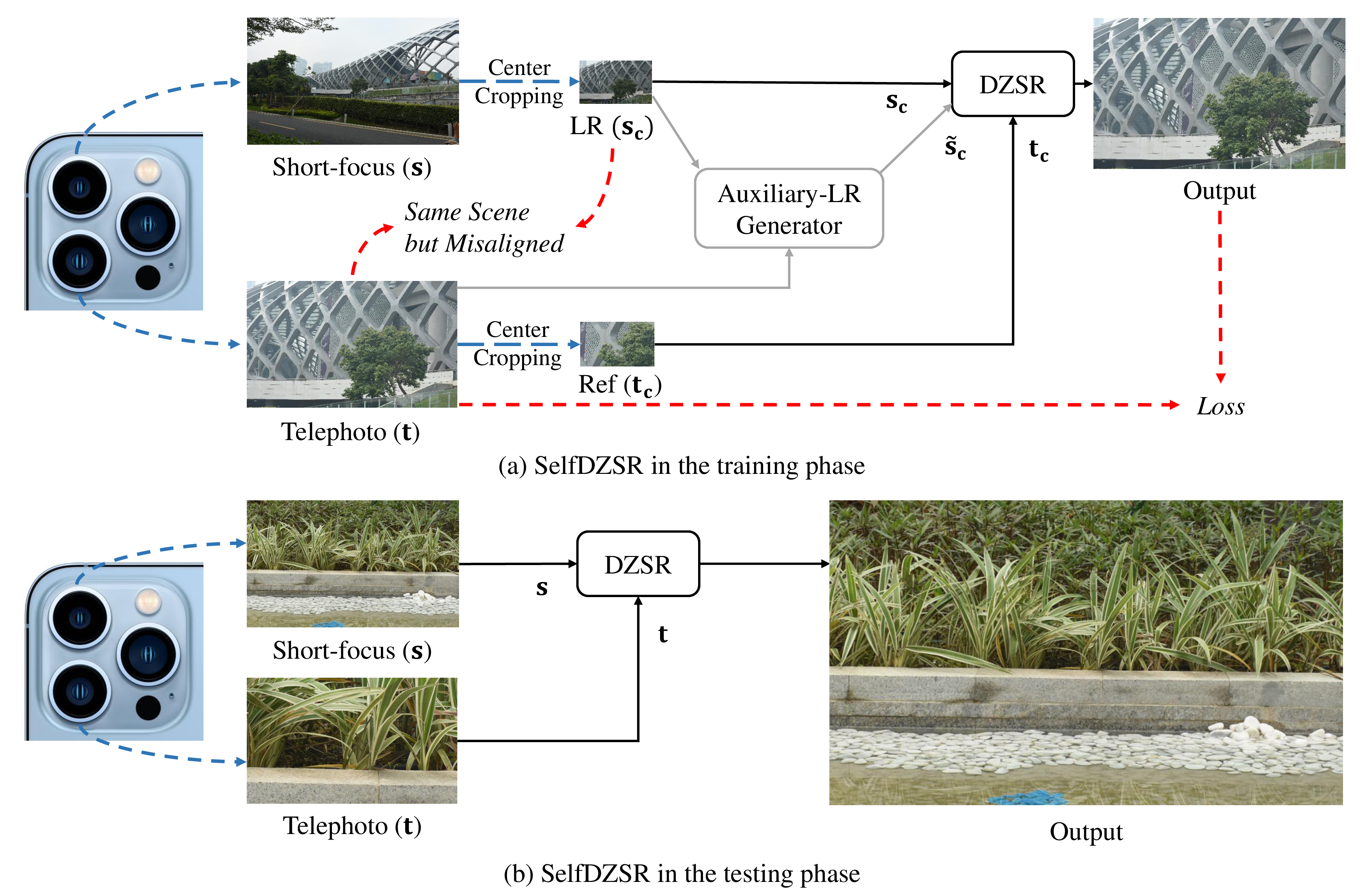Official PyTorch implementation of SelfDZSR
Self-Supervised Learning for Real-World Super-Resolution from Dual Zoomed Observations
ECCV, 2022
Zhilu Zhang, Ruohao Wang, Hongzhi Zhang, Yunjin Chen, Wangmeng Zuo
Harbin Institute of Technology, China
The extended version of SelfDZSR has been accepted by IEEE TPAMI in 2024.
Self-Supervised Learning for Real-World Super-Resolution from Dual and Multiple Zoomed Observations
IEEE TPAMI, 2024
Zhilu Zhang, Ruohao Wang, Hongzhi Zhang, Wangmeng Zuo
Harbin Institute of Technology, China
GitHub: https://github.com/cszhilu1998/SelfDZSR_PlusPlus
Overall pipeline of proposed SelfDZSR in the training and testing phase.
-
In the training, the center part of the short-focus and telephoto image is cropped respectively as the input LR and Ref, and the whole telephoto image is taken as the GT. The auxiliary-LR is generated to guide the alignment of LR and Ref towards GT.
-
In the testing, SelfDZSR can be directly deployed to super-solve the whole short-focus image with the reference of the telephoto image.
-
Prerequisites
- Python 3.x and PyTorch 1.6.
- OpenCV, NumPy, Pillow, tqdm, lpips, scikit-image and tensorboardX.
-
Dataset
- Nikon camera images and CameraFusion dataset can be downloaded from this link.
-
Data pre-processing
- If you want to pre-process additional short-focus images and telephoto images, we provide a demo in
./data_preprocess. (2022/9/13)
- If you want to pre-process additional short-focus images and telephoto images, we provide a demo in
-
For simplifying the training process, we provide the pre-trained models of feature extractors and auxiliary-LR generator. The models for Nikon camera images and CameraFusion dataset are put in the
./ckpt/nikon_pretrain_models/and./ckpt/camerafusion_pretrain_models/folder, respectively. -
For direct testing, we provide the four pre-trained DZSR models (
nikon_l1,nikon_l1sw,camerafusion_l1andcamerafusion_l1sw) in the./ckpt/folder. Takingnikon_l1swas an example, it represents the model trained on the Nikon camera images using$l_1$ and sliced Wasserstein (SW) loss terms.
-
For Nikon camera images, modify
datarootintrain_nikon.shand then run: -
For CameraFusion dataset, modify
datarootintrain_camerafusion.shand then run:
-
For Nikon camera images, modify
datarootintest_nikon.shand then run: -
For CameraFusion dataset, modify
datarootintest_camerafusion.shand then run:
- You can specify which GPU to use by
--gpu_ids, e.g.,--gpu_ids 0,1,--gpu_ids 3,--gpu_ids -1(for CPU mode). In the default setting, all GPUs are used. - You can refer to options for more arguments.
If you find it useful in your research, please consider citing:
@inproceedings{SelfDZSR,
title={Self-Supervised Learning for Real-World Super-Resolution from Dual Zoomed Observations},
author={Zhang, Zhilu and Wang, Ruohao and Zhang, Hongzhi and Chen, Yunjin and Zuo, Wangmeng},
booktitle={European Conference on Computer Vision (ECCV)},
year={2022}
}
@article{SelfDZSR_PlusPlus,
title={Self-Supervised Learning for Real-World Super-Resolution from Dual and Multiple Zoomed Observations},
author={Zhang, Zhilu and Wang, Ruohao and Zhang, Hongzhi and Zuo, Wangmeng},
journal={IEEE Transactions on Pattern Analysis and Machine Intelligence (TPAMI)},
year={2024},
publisher={IEEE}
}
This repo is built upon the framework of CycleGAN, and we borrow some code from C2-Matching and DCSR, thanks for their excellent work!
